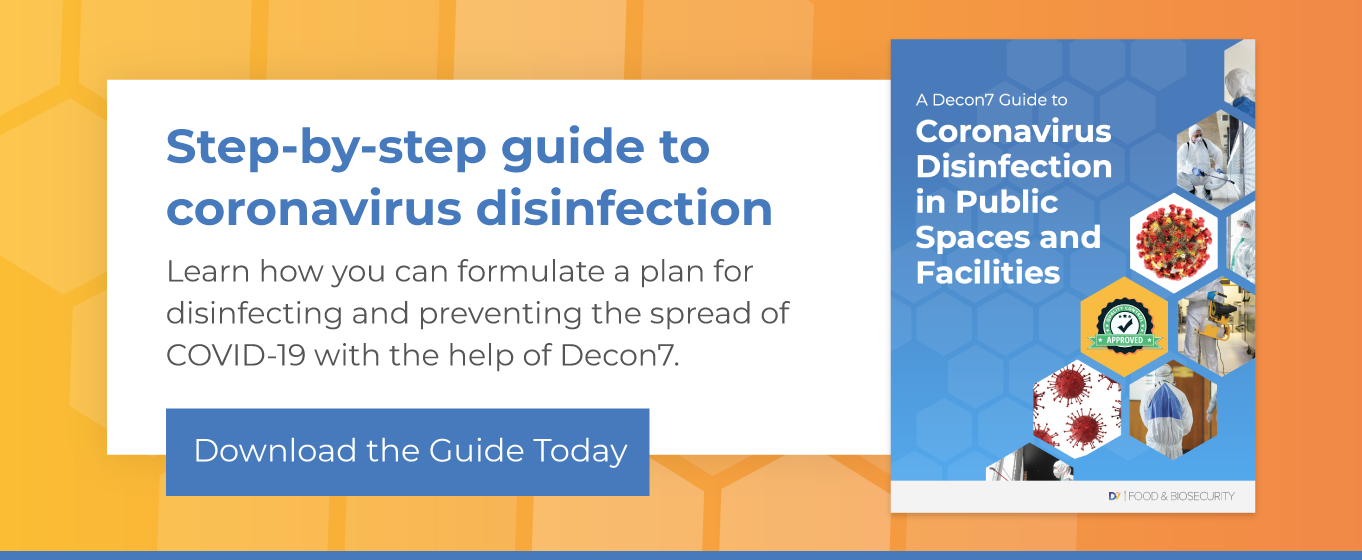Many people are understandably concerned about coronavirus on surfaces and how long it can stay on different types of materials. As local and national governments continue to take steps to slow the spread of the virus and fewer people come into contact with each other, the possibility of spreading through non-contact means remains. For businesses operating in the food supply chain, landlords turning over apartments, hotel operators, and quarantined individuals receiving packages, it’s important to understand how coronavirus on surfaces can potentially present a risk of exposure.
How Do Viruses Spread on Surfaces?
Although COVID-19 is mainly spread from person to person, like other types of viruses, it can live on surfaces and spread to other individuals who come into contact with those surfaces. When a person coughs or sneezes, droplets settle on the surrounding surfaces and stay there for a period of time. If you touch an infected surface, it is possible to transmit the virus if you then touch your mouth, nose, or eyes before washing your hands.
How Long Can a Virus Last on Specific Surfaces?
A recent study by researchers at NIH’s National Institute of Allergy and Infectious Diseases (NIAID) found that the virus remained active on various surfaces for different lengths of time:
- Up to 2-3 days on plastic and steel
- Up to 24 hours on cardboard
- Up to four hours on copper
A number of factors play a role in how long coronavirus on surfaces will remain active, including how much of the virus was initially deposited, temperature, humidity, and other surrounding conditions. Specific research has not yet been conducted regarding the viability of COVID-19 on soft surfaces such as carpets and clothing, but the CDC provides recommendations for handling softer items that are known to have come into contact with an infected individual.
Because many people are receiving items from Amazon and other online providers, there is some concern about the risk of spreading the virus through packages. According to the CDC’s FAQ page, “In general, because of poor survivability of these coronaviruses on surfaces, there is likely very low risk of spread from products or packaging that are shipped over a period of days or weeks at ambient temperatures.”
Tips for Proper Sanitation
Because the virus can live on surfaces for at least several hours, the CDC’s Disinfection Guidance recommends frequently cleaning and disinfecting high-touch surfaces such as doorknobs, tables, light switches, sinks, toilets, and other hard surfaces. The CDC also recommends frequently washing hands with soap and water for at least 20 seconds, especially after coming in contact with surfaces that may be contaminated with the virus. Wear disposable gloves while cleaning potentially contaminated surfaces, and wash your hands after removing the gloves. If using reusable gloves, use them only for the purpose of cleaning potentially contaminated surfaces and not for other household purposes.
The products you use also make a difference. For example, ammonia or chlorine bleach wipes are effective against viruses, but standard baby wipes may not be. Additionally, natural cleaning products like vinegar are not as effective against viruses, so it’s best to stick to the list of products that have been pre-approved by the EPA to ensure that you are using an effective disinfectant.
D7 and Coronavirus on Surfaces
D7 has demonstrated effectiveness against viruses similar to coronavirus or COVID-19 on hard,
non-porous surfaces. It qualifies for emerging viral pathogen claims per the EPA’s “Guidance to Registrants: Process for Making Claims Against Emerging Viral Pathogens not on EPA-Registered labels” when used in accordance with the appropriate use directions. D7 qualifies for emerging pathogen claims against enveloped viruses and large, non-enveloped viruses, which means it can be used against COVID-19 when used in accordance with the directions for use against norovirus. Refer to the CDC website for additional information.
The D7 Difference
Of course, the list of approved products is a long one, but that does not mean that they are all equally effective. When selecting a product, look at factors such as the log kill (a higher number means more pathogens are destroyed), application method, recommended contact time, and safety considerations. Look for a disinfectant with detergent, because the soap in the formulation can handle heavier soils and also penetrates the cell membranes to neutralize viruses. D7 provides a greater than 6-log reduction of pathogens, and detergent is a key ingredient of the patented disinfectant foam.
The combination of social distancing and frequent disinfection is believed to help slow the spread of COVID-19. Whether you are a concerned individual, FSQA manager, healthcare provider, or decontamination professional, everybody plays a role in helping to prevent the spread of this virus. D7 is here to provide solutions that are both effective and easy to apply. Ask us about viral disinfection if you’d like to learn more about how D7 is different.

